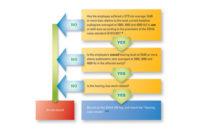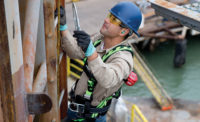
It is a misconception that hearing-impaired or deaf workers do not have to participate in a hearing conservation program. Like those with normal hearing, these workers still fall under OSHA, MSHA and FRA regulations for occupational noise exposures. Employers are still required to provide annual audiometry and training, and those workers exposed to levels above 90 dBA must wear hearing protection devices (HPD). Workers with a documented hearing loss, or Standard Threshold Shift (STS) are required to wear HPDs at 85 dBA.

Figure 1: Percentage of adults* who reported being deaf or having a lot of trouble hearing without a hearing aid, by sex and age group — United States, 2003
In the 2003 National Health Survey, (Figure 1) the percentage of adults aged 18 years and older who reported being deaf or having a lot of trouble hearing increased with age, from 1 percent in persons aged 18-44 years to 15 percent in persons over 75 years old. In 2006, 37 million adults in the U.S. had trouble hearing, representing a substantial increase since 2000 when 31.5 million U.S. adults reported trouble hearing.
These impairments may be due to occupational exposures, biological diseases, genetic defects or natural aging. Military veterans returning from active combat — and returning to the workplace — have higher incident rates of NIHL than ever before.
This article will focus on how to best accommodate and manage hearing-impaired workers, using best practices to manage personal behaviors and new technologies to manage noise exposures.
Hearing protectors
Hearing-impaired and deaf workers are still required to use hearing protection when exposed to hazardous noise levels. Several options are available:- Uniform Attenuation – For workers with a mild to moderate hearing loss, a solution may be passive earplugs and earmuffs that offer uniform attenuation. Flat or uniform attenuation hearing protectors block low and medium frequencies but let higher frequencies be heard more naturally. Many of these uniform-attenuating HPDs offer moderate attenuation and are good for workers exposed to lower levels of hazardous noise. These are also a good option for workers who prefer to wear their hearing aids while working.
- Electronic Sound Amplification – For those with a mild hearing loss, earmuffs that deliver sound amplification may provide added hearing assistance in moderate levels of noise.
- Noise Exposure Monitoring / In-Ear Dosimetry – In-ear dosimetry measures in real time the amount of noise dose workers accumulate during a workday with and without hearing protection. This helps determine if a worker is properly protected or has achieved additional noise exposures and is at risk for additional hearing loss.
- Hearing Protector Fit Testing – If an employee has some hearing loss, special hearing protection may be needed to both protect hearing and allow situational awareness for safe operations. Fit-testing earplugs can help ensure the right amount of protection.
- Hearing Aids as Hearing Protectors – Hearing aids are generally not good hearing protectors, however some hearing aids could be used as hearing protectors, such as “completely in the canal,” or CIC, hearing aids that have a deep insertion into the ear canal and are turned to the off position. A supervisor or safety manager must know whether or not the worker has turned them off in order to be properly protected. CICs also may only provide a lower level of attenuation, and are not suited for high levels of hazardous noise.
OSHA SHIB
In 2005, OSHA published a Safety and Health Bulletin titled “Innovative Workplace Safety Accommodations for Hearing-Impaired Workers. ” This bulletin provides recommendations including strobe lighting for visual cues, vibrating alarms, and buddy systems that pair healthy hearing with hearing-impaired workers.Training + care
- Workers as Role Models – Workers whose hearing loss is due to occupational or military exposures might be willing to share testimonials about the value of maintaining healthy hearing in training sessions with their peers.
- Clear Communication – When conversing with these workers, make sure that you face the person directly, standing in light, and speak as clearly as possible.
- Hearing Protectors and Hearing Aids – It is highly recommended that workers who wear both hearing aids and hearing protection consult with an audiologist before wearing them. The audiologist will be able to advise regarding what type of hearing aid might work best with hearing protection and how loud the person can turn up their hearing aids so that they mitigate any distortion or feedback sounds.
References
1 www.cdc.gov/mmwr/preview/mmwrhtml/mm5425a5.htm2Health Disparities Among Adults With Hearing Loss: United States, 2000-2006. by Charlotte A. Schoenborn, M.P.H., and Kathleen Heyman, M.S. Division of Health Interview Statistics. www.cdc.gov/nchs/data/hestat/hearing00-06/hearing00-06.htm
3 Schulz, TY.Troops Return with Alarming Rates of Hearing Loss. Hearing Health, Fall 2004. Cited 4.15.11 from www.nmcphc.med.navy.mil/downloads/occmed/toolbox/ hearing%20health%20article%20-troops%20return%20with%20 alarming%20rates%20of%20hl.pdf
4 Schulz, TY.Key Hearing Conservation Issues for 2011 and Beyond. Professional Safety, April 2011. cited 4.15.11 from www.asse.org/professionalsafety/best-practices.php
5 Morata TC, Themann CL, Randolph RF, Verbsky BL, Byrne DC, Reeves ER.Working in noise with a hearing loss: Perceptions from workers, supervisors and hearing conservation program managers. Noise Health 2006;8:61-2
6 Rink, T.L. (1979).Hearing Protection and Speech Discrimination in Hearing-Impaired Persons. Sound and Vibration,Vol. 13 No.1, 22-25.]
7 www.osha.gov/dts/shib/shib072205.html 8 Verbsky, Babette.“Hearing Aids + Earmuffs: Counter-Intuitive Hearing Conservation.” CAOHC Update, Summer 2004.


